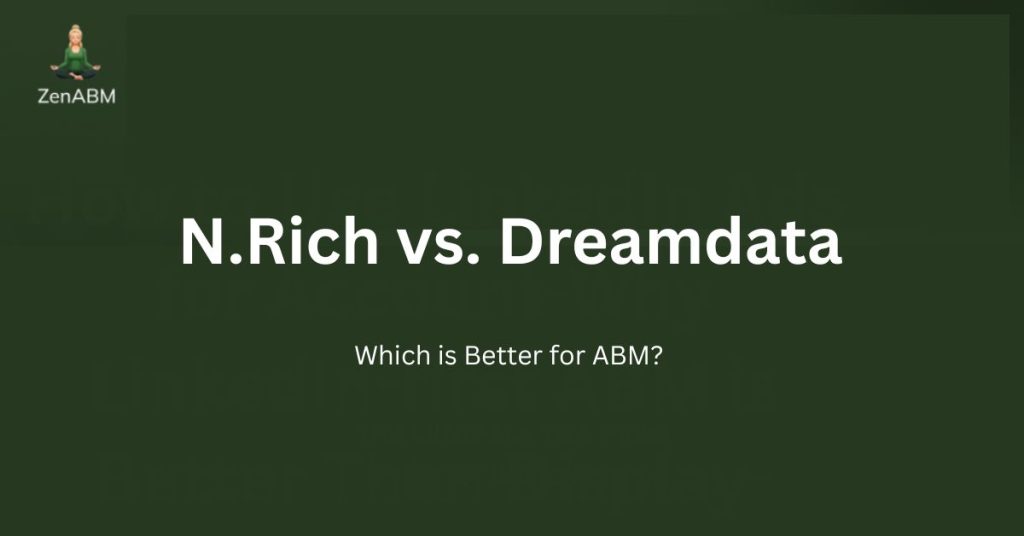In this guide, I break down how N.Rich vs. Dreamdata differ on features, pricing, and where they fit in an ABM stack, so marketing and sales can see which one suits their ABM motion.
I also show how ZenABM can act as a lean, LinkedIn-first alternative or sit on top of either tool as a complementary layer due to its unique features.

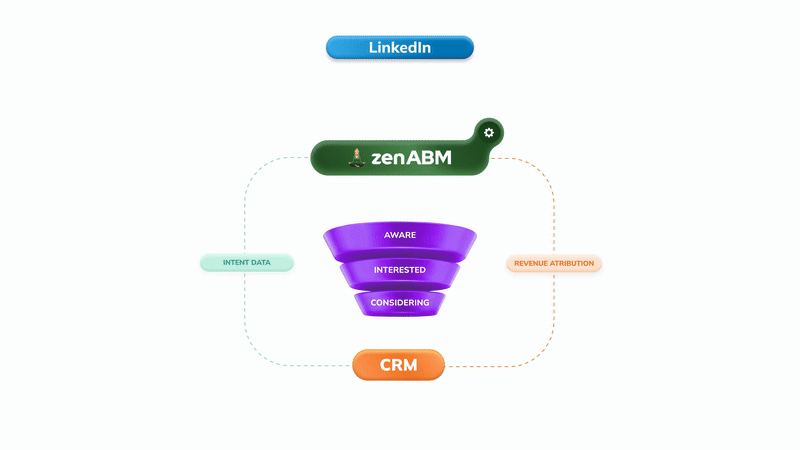
N.Rich vs. Dreamdata: Quick Summary
In case you’re short on time, here is the snapshot:
- N.Rich is an ABM execution platform with its own DSP, CRM driven ICP builder, intent scoring, and account-level analytics for mid-market and enterprise teams.
- Dreamdata is a revenue attribution and activation platform that maps multi-touch journeys and reports pipeline and revenue by channel, campaign, and content.
- N.Rich focuses on picking and scoring the right accounts, running programmatic plus LinkedIn, and tying impressions and clicks to opportunities.
- Dreamdata focuses on journey mapping, multi-touch attribution models, revenue analytics, and sending conversion and audience signals back to ad platforms.
- N.Rich pricing starts above $10K per year plus onboarding, and scales with topics, seats, and campaigns.
- Dreamdata has a free tier, but serious activation and attribution features move into higher, more premium pricing.
- A third option: ZenABM gives account-level LinkedIn ad engagement, engagement to pipeline dashboards, account scoring, ABM stages, CRM sync, first-party qualitative intent, automated BDR assignment, custom webhooks, an AI chatbot, and job title level engagement tracking, starting at $59 per month.
N.Rich Overview: Key Features, Pricing, and Reviews
N.Rich presents itself as an agile ABM execution layer for mid-market and enterprise teams, built on top of a B2B DSP with intent, ICP, and ABM workflows.
Key Features of N.Rich
Core N.Rich capabilities for ABM include ICP building, intent scoring, programmatic campaigns, and account-level analytics.
Dynamic ICP & Target Account Lists
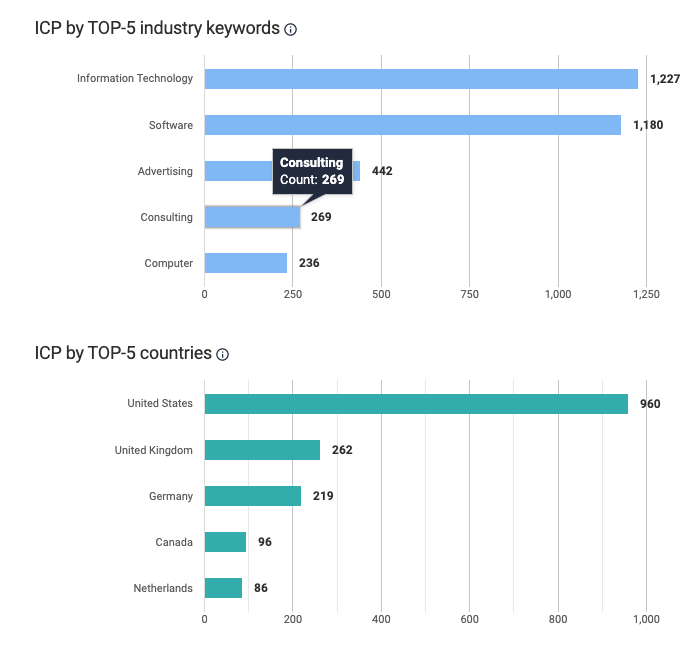
N.Rich pulls in CRM opportunity data to learn what your best customers look like, then scores new accounts against that pattern. Target lists can be built quickly using filters such as industry, employee count, and tech stack.
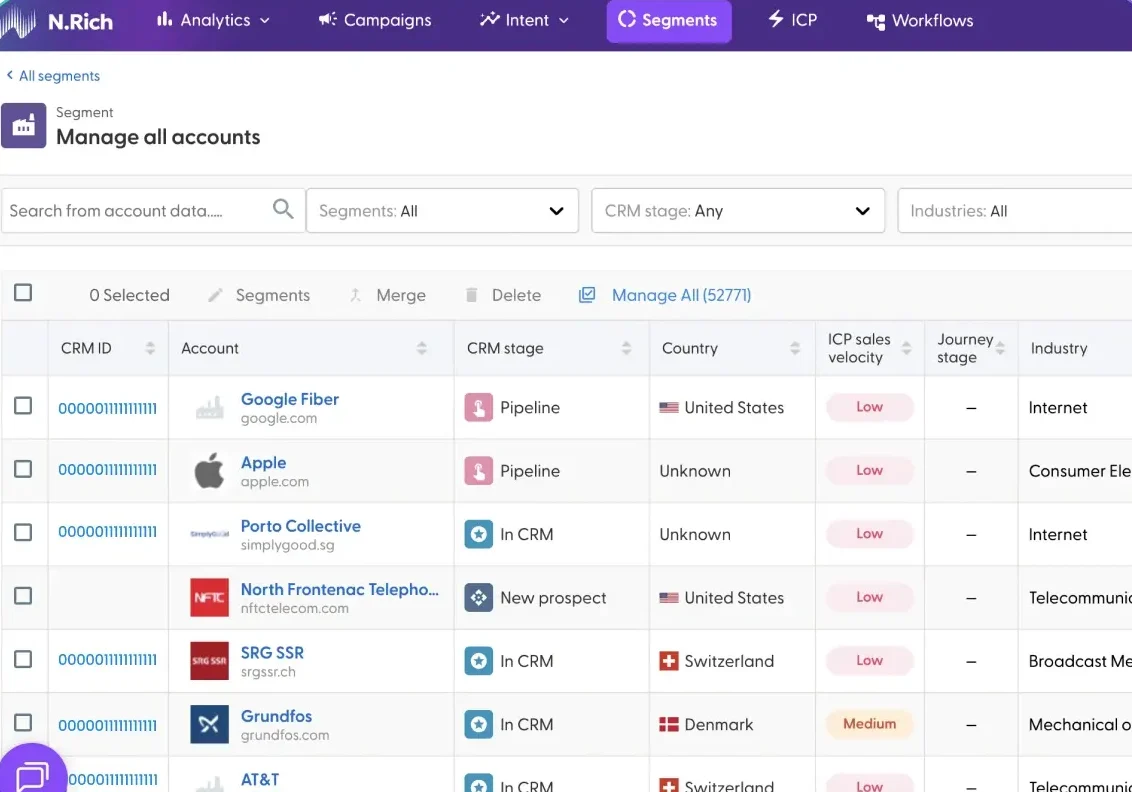
The idea is to move beyond gut feel account picks, although results still depend on CRM data quality.
Intent Data & Account Scoring
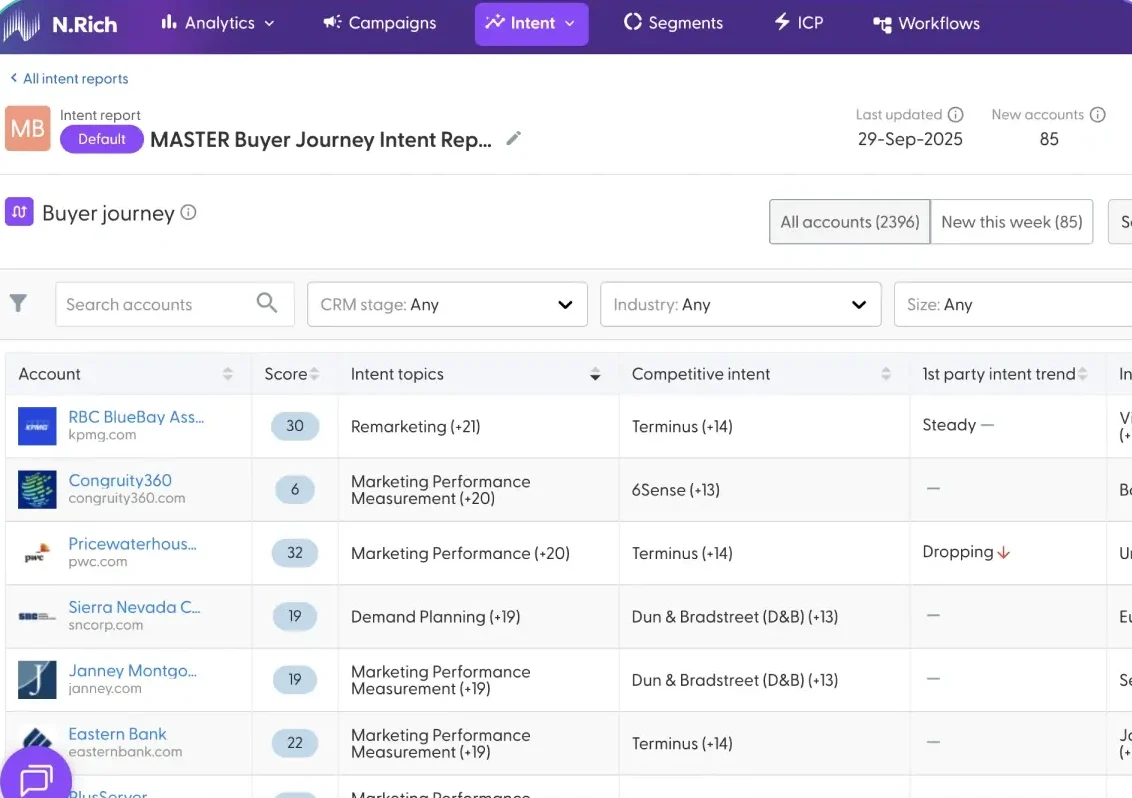
N.Rich blends first party signals (site visits, ad engagement) with third party intent feeds to highlight accounts researching key topics. Accounts receive intent scores so sales and marketing can focus on those showing the strongest, consent-based interest, while topic data syncs into your CRM.
Account-Based Advertising
N.Rich ships with a built-in DSP to run programmatic display to target accounts, supporting native and video formats.
You can connect LinkedIn Ads to keep display and LinkedIn campaigns aligned, and reviewers note a simple campaign builder with bulk creatives and A/B tests.
Analytics & Opportunity Attribution
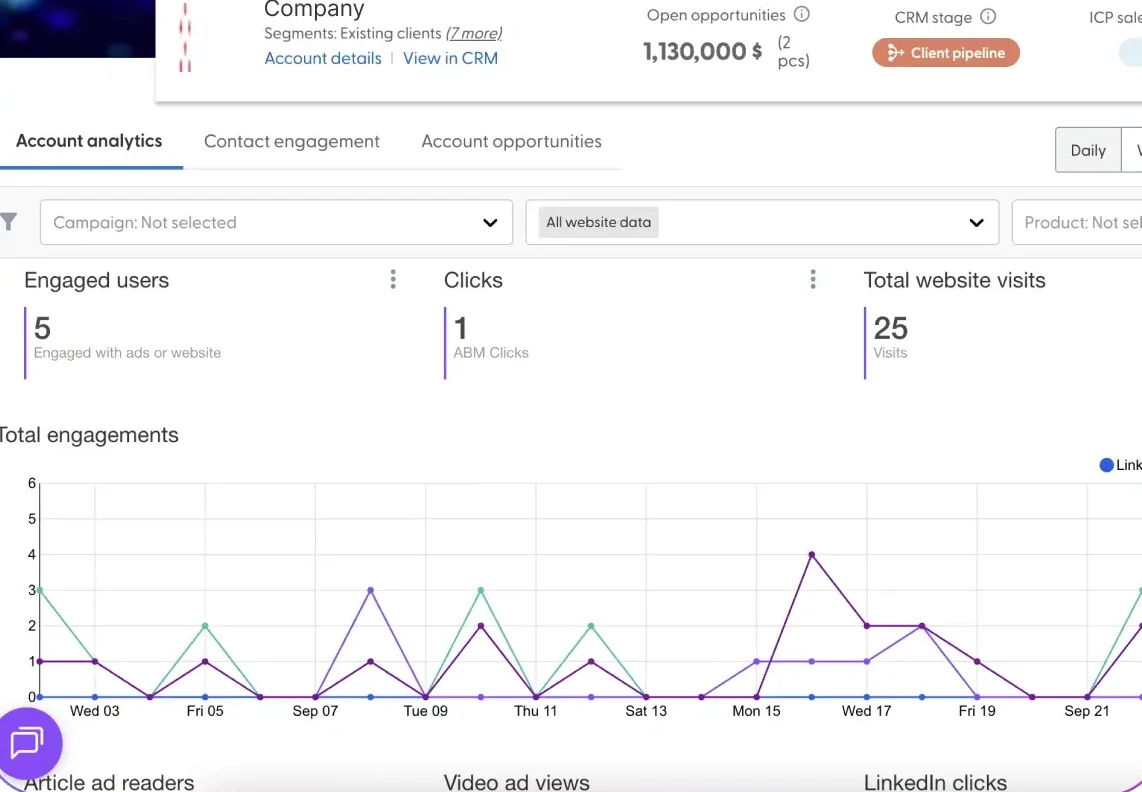
N.Rich provides account-level analytics so you can see how engagement connects to pipeline and revenue. Its Opportunity Attribution dashboard links impressions, clicks, and visits with opportunities and closed deals.
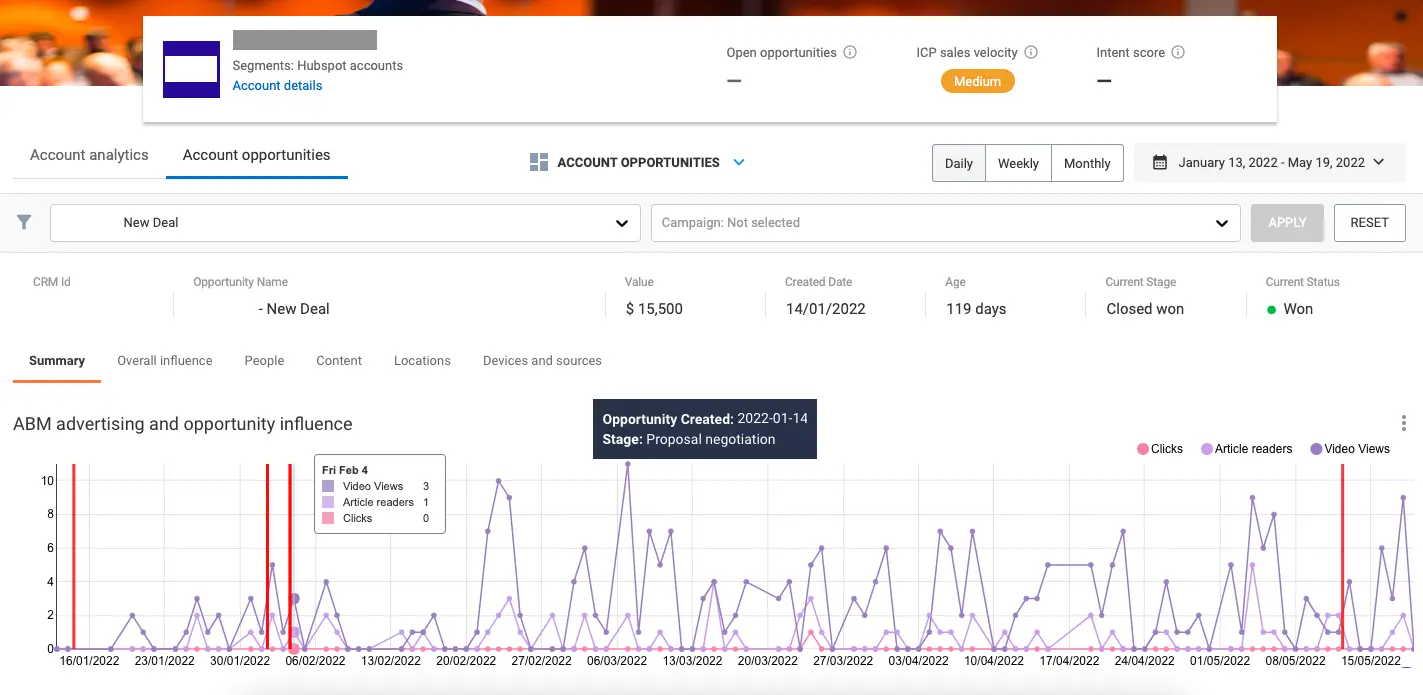

The system also calculates an ICP Sales Velocity Score for each account, with data sync back to the CRM on higher tiers.
Integrations & Data Enrichment
N.Rich integrates with the main CRMs and marketing tools. Native connectors exist for Salesforce, HubSpot (Marketing and Sales Hub), and LinkedIn (Marketing Solutions and Sales Navigator), letting you pull CRM data for segmentation and push back engagement, topics, and scores. Higher tiers add firmographic and technographic enrichment.
N.Rich Pricing: How Much Does It Cost?

N.Rich has tiered pricing tied to team size and ABM maturity. All plans aim to turn intent data into deals.
LITE: Starting at $10,320/year + $1,050 One-Time Onboarding Fee
For smaller teams starting with intent-driven ABM.
Includes 1 intent report, 10 topics, 1 marketing seat, 3 sales seats, 1 N.Rich account, 1 ABM campaign, chat support, plus:
- Intent scoring
- Unlimited firmographic and technographic data
- Website visitor identification
- Basic account analytics and alerts
GROWTH: Starting at $23,800/year
For teams scaling ABM and needing closer sales and marketing alignment.
Includes everything in LITE plus:
- More intent reports and topics
- More marketing seats and unlimited sales seats
- CRM and MAP integrations
- Opportunity attribution and more ABM campaigns
- Dedicated Customer Success Manager
ENTERPRISE: Custom Pricing
For global, mature ABM programs with advanced orchestration needs.
Includes everything in GROWTH plus:
- Unlimited intent reports and higher topic limits
- Unlimited users and multiple N.Rich accounts
- Dynamic ICP Builder and open API
- Automated workflows and strategic consulting
All plans benefit from N.Rich’s data depth and native ABM orchestration, but you still need to talk to sales for exact quotes.
Note: because N.Rich starts above $10K per year, ZenABM often looks leaner for LinkedIn first teams, starting at ~$59/month, with the top tier still under $6K per year. You still get core LinkedIn ABM essentials: account-level ad engagement tracking, account scoring, ABM stage tracking, hot account routing, bi-directional CRM sync, custom webhooks, qualitative intent, and plug-and-play ROI dashboards.

User Impressions and Reviews
N.Rich scores 4.7 out of 5 on G2 (around 99 reviews), which suggests customers are broadly satisfied.
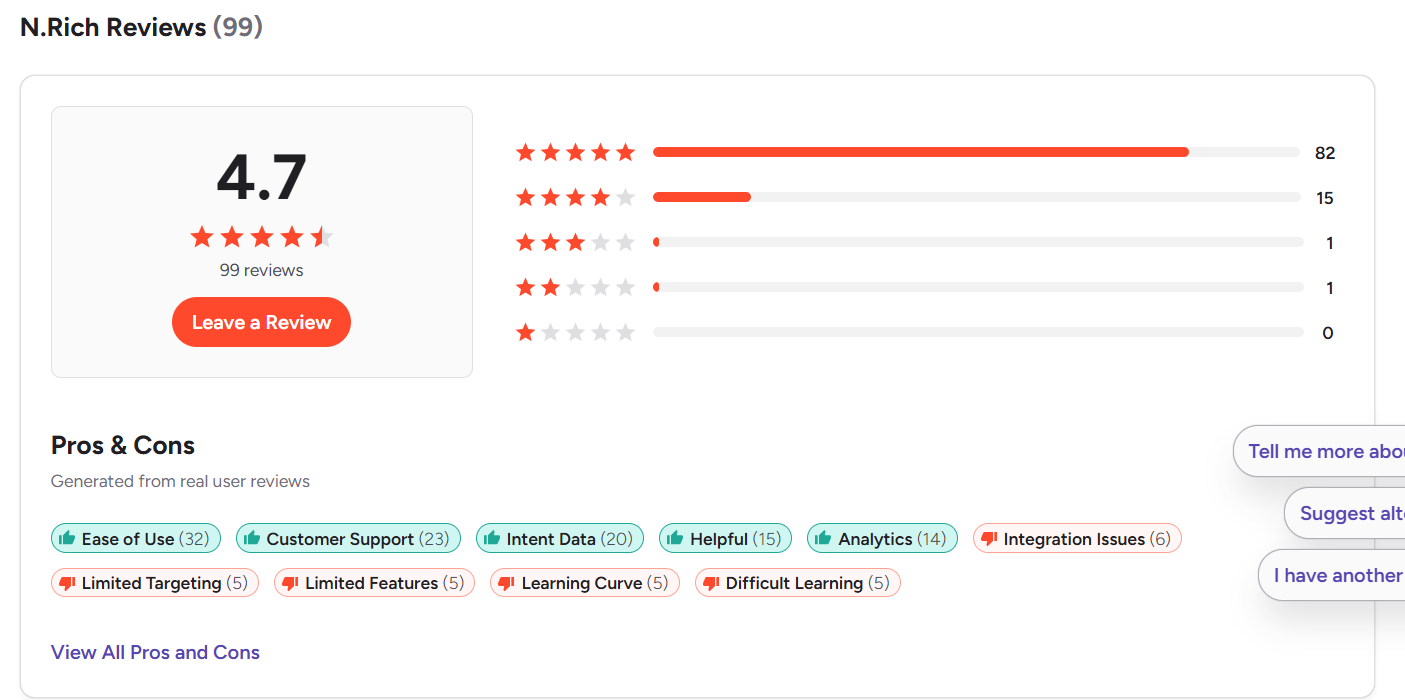
Across G2, TrustRadius, Reddit, and similar sources, a few themes show up.
Pros (According to Users)
- Support that shows up: Reviewers often describe N.Rich’s support as responsive and proactive, with regular check ins that are not just upsells.
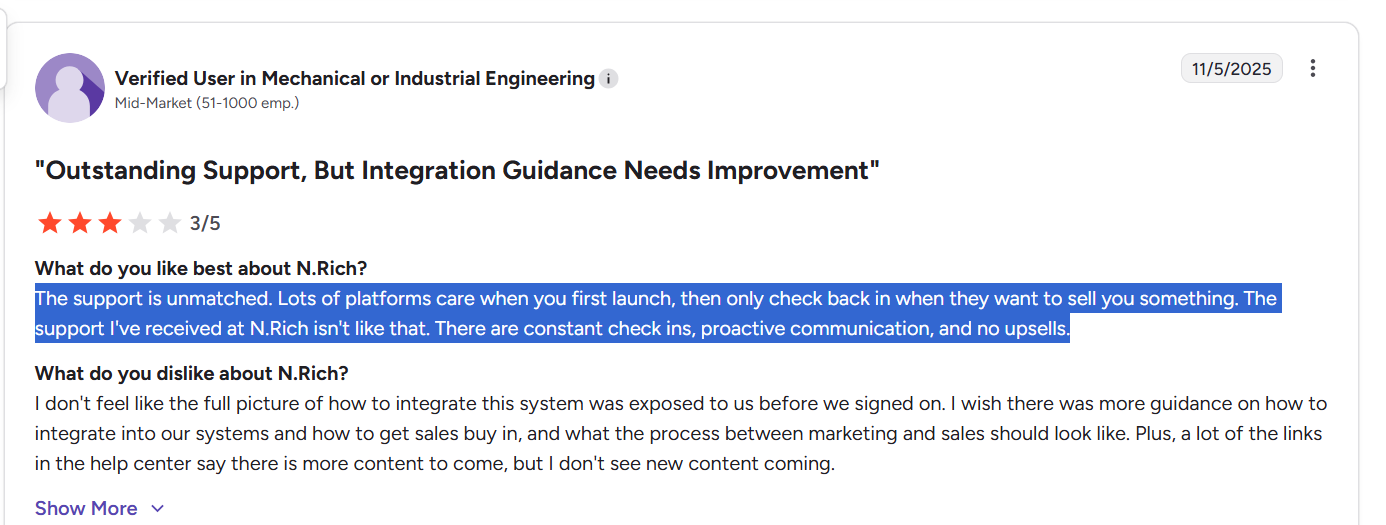
- Usable once configured: Many call it easy and even “fun” to use once lists, reports, and campaigns are in place.
- Strong intent and targeting: Users praise the quality of intent and account selection for focusing ad spend on high value accounts.
Cons (According to Users)
- Setup takes work: Onboarding, data mapping, and reporting usually need ops involvement.
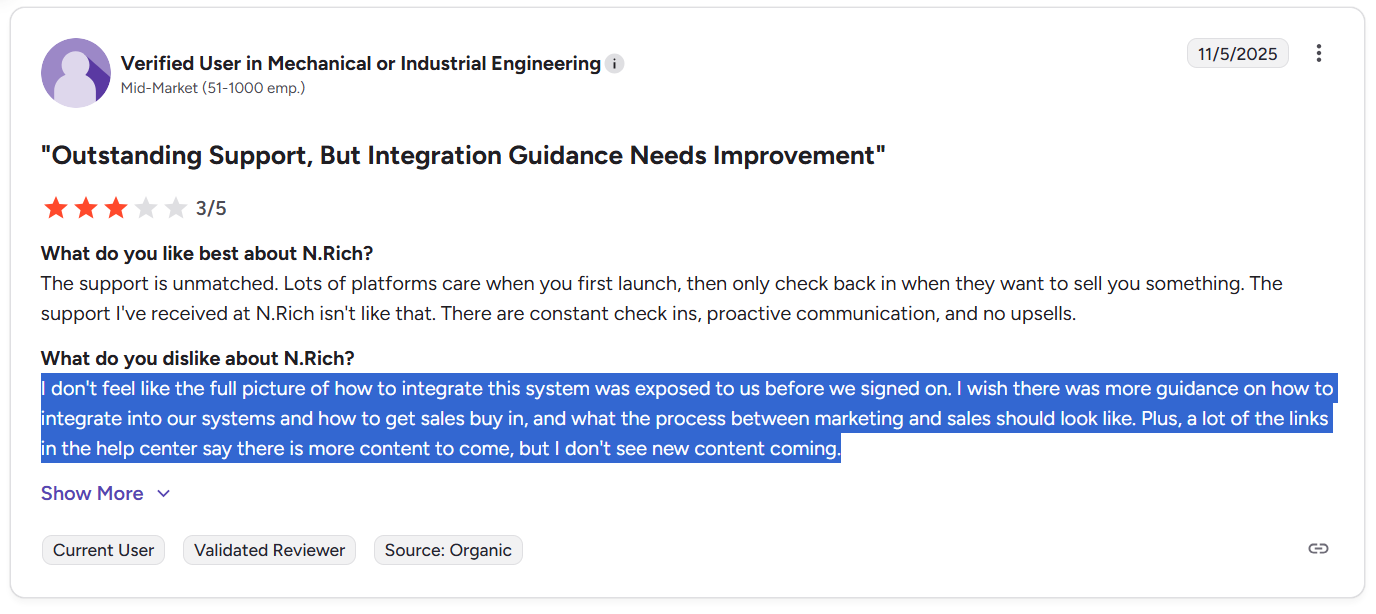
- Integrations need clearer guidance: Some reviewers report integration surprises and wish the full picture had been clearer before signing.
- Feature gaps: A few users mention limits around ad copy, session timeouts, or glitches.
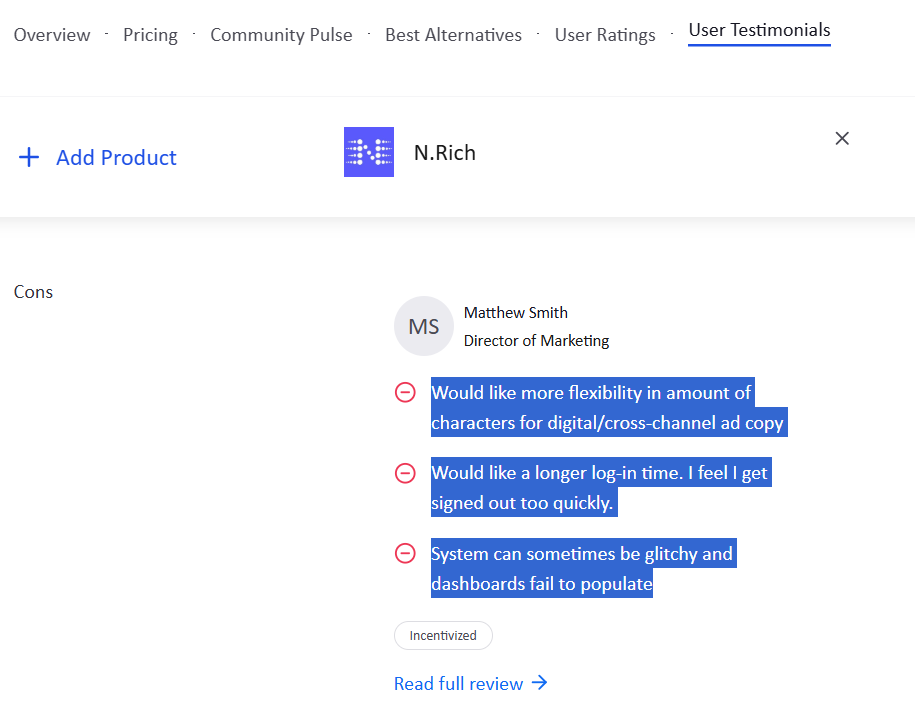
Dreamdata Overview: Key Features, Pricing, and Reviews
Dreamdata bills itself as a B2B “Activation and Attribution Platform” that maps buyer touchpoints and ties them to revenue.
Key Features of Dreamdata
Dreamdata aims to be a central place to connect marketing spend to revenue.
Multi-Touch Attribution Models
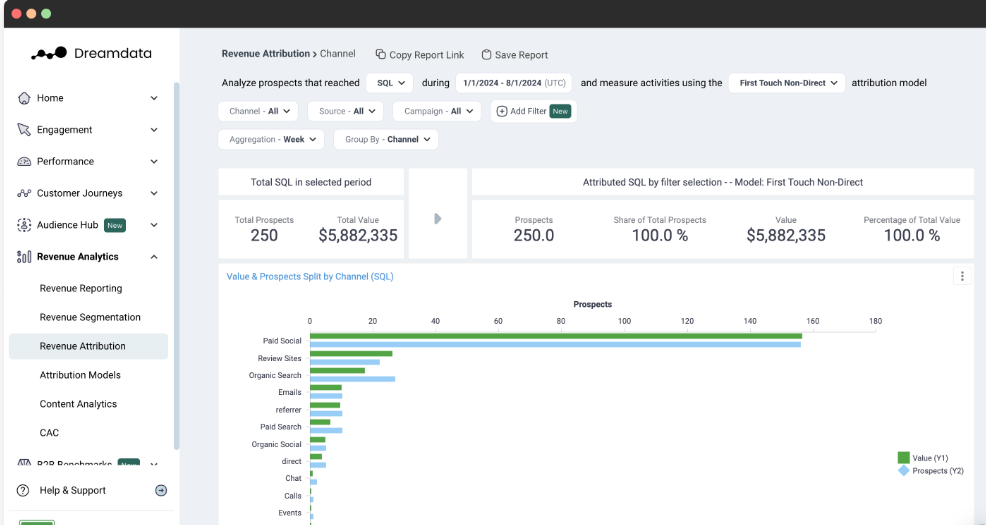
Dreamdata provides several attribution models, such as first touch, last touch, W-shaped, time decay, and data-driven options. It aggregates CRM, website, and ad data into a single timeline so you can see how content and campaigns contributed to a deal, not just the last click.
Revenue Analytics & Funnel Reporting
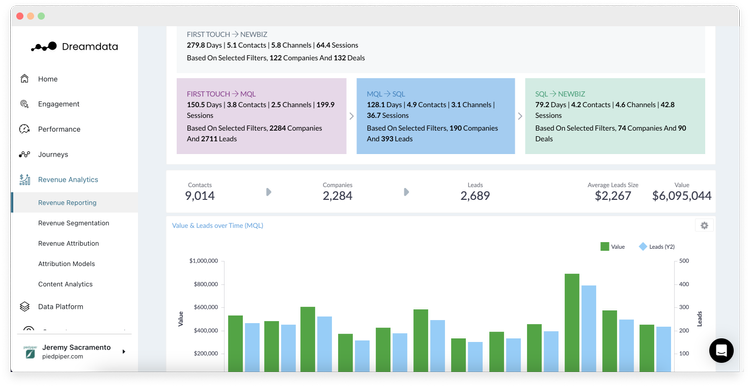
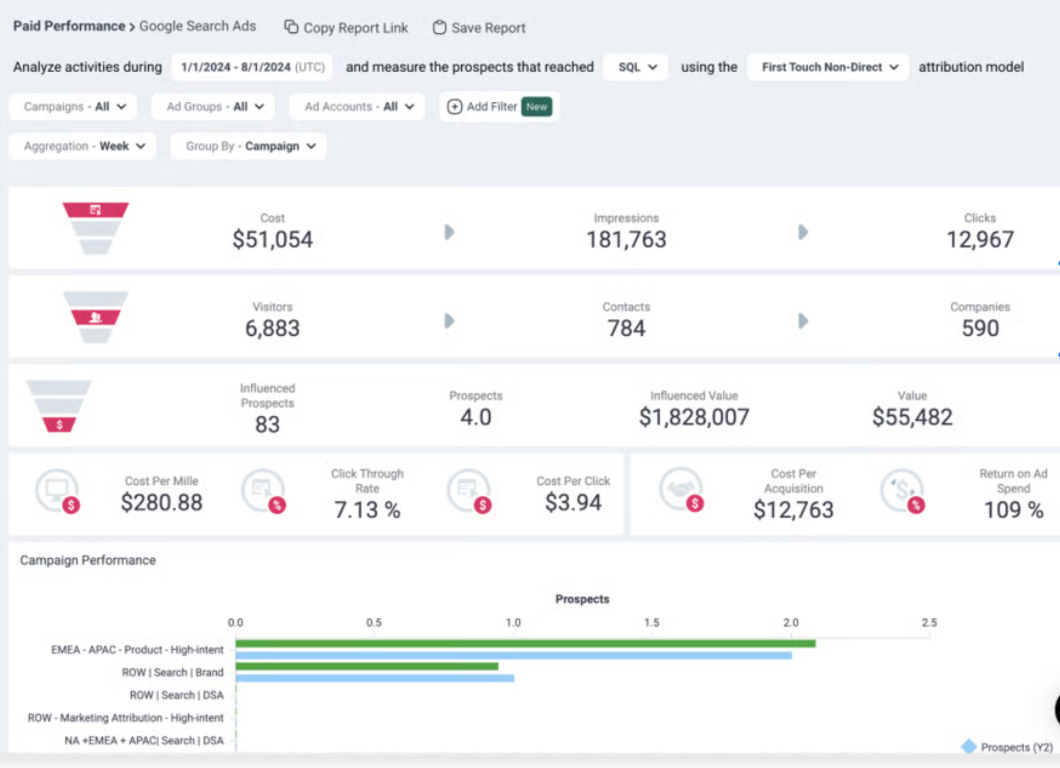
Dreamdata rolls data into revenue analytics dashboards, showing pipeline and ROI by channel, campaign, and content. You can track metrics like Time to Revenue and pipeline velocity by stage. Some users on G2 note that not all pre-built reports are useful, and the learning curve is real.
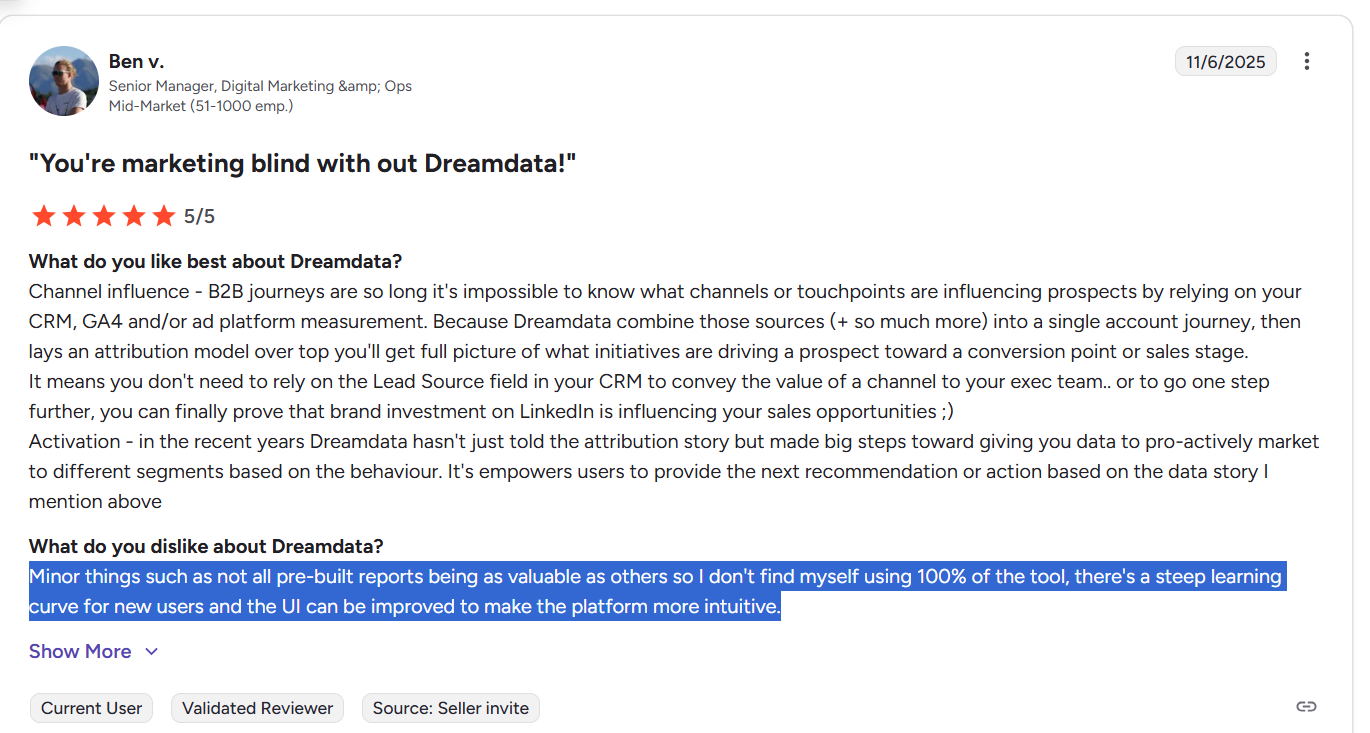
By the way, ZenABM also provides account-based LinkedIn ad revenue attribution dashboards starting at $59/month.
Account-Based Data Views (ABM Capabilities)
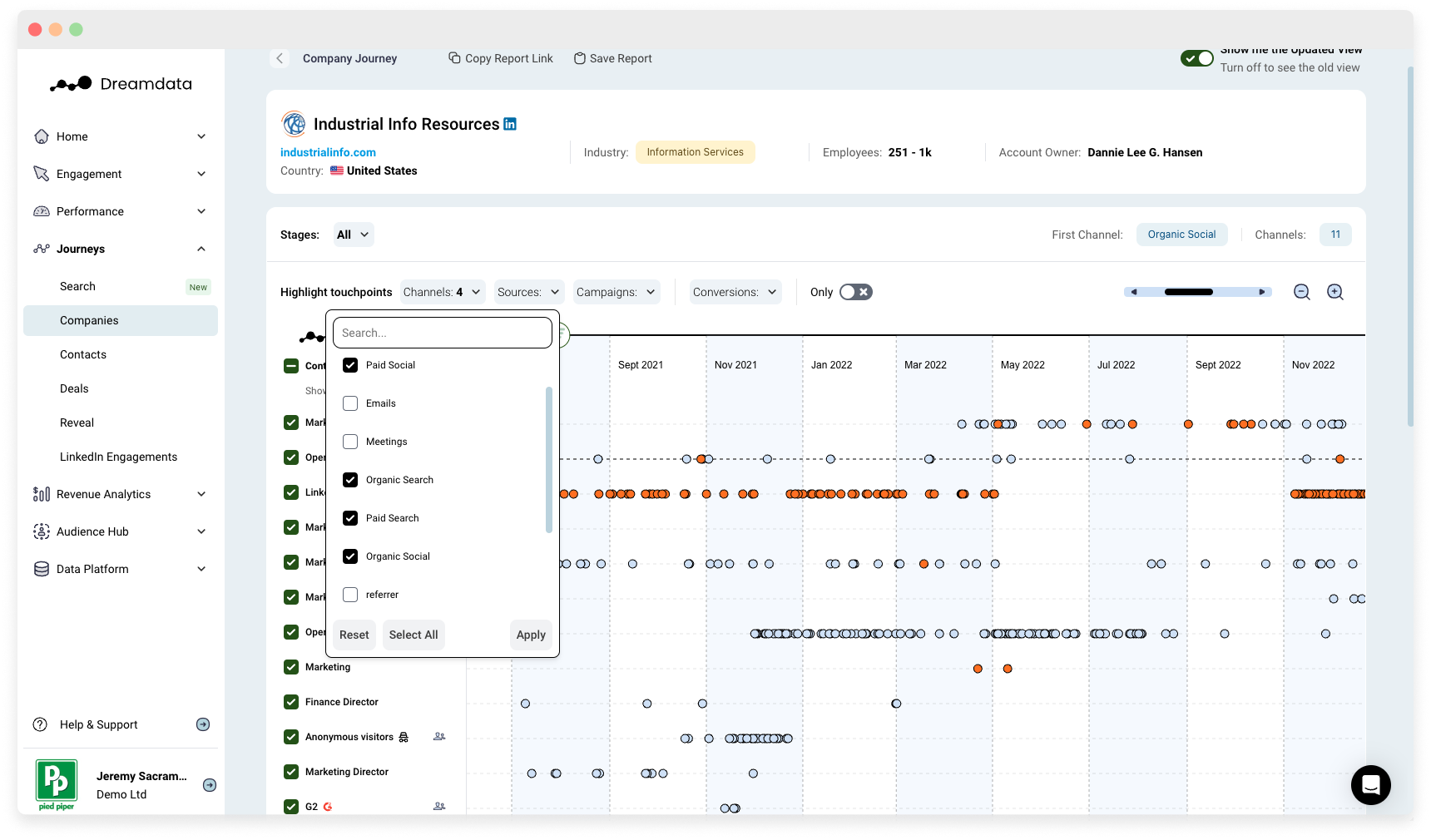
Dreamdata automatically organizes contact-level touchpoints into account journeys so you see how buying committees move from first touch to close. Its ABM view helps marketing show influence on deals and track account-level engagement.

The “Reveal” module identifies which companies are engaging most, scores their activity, and flags high fit visitors.
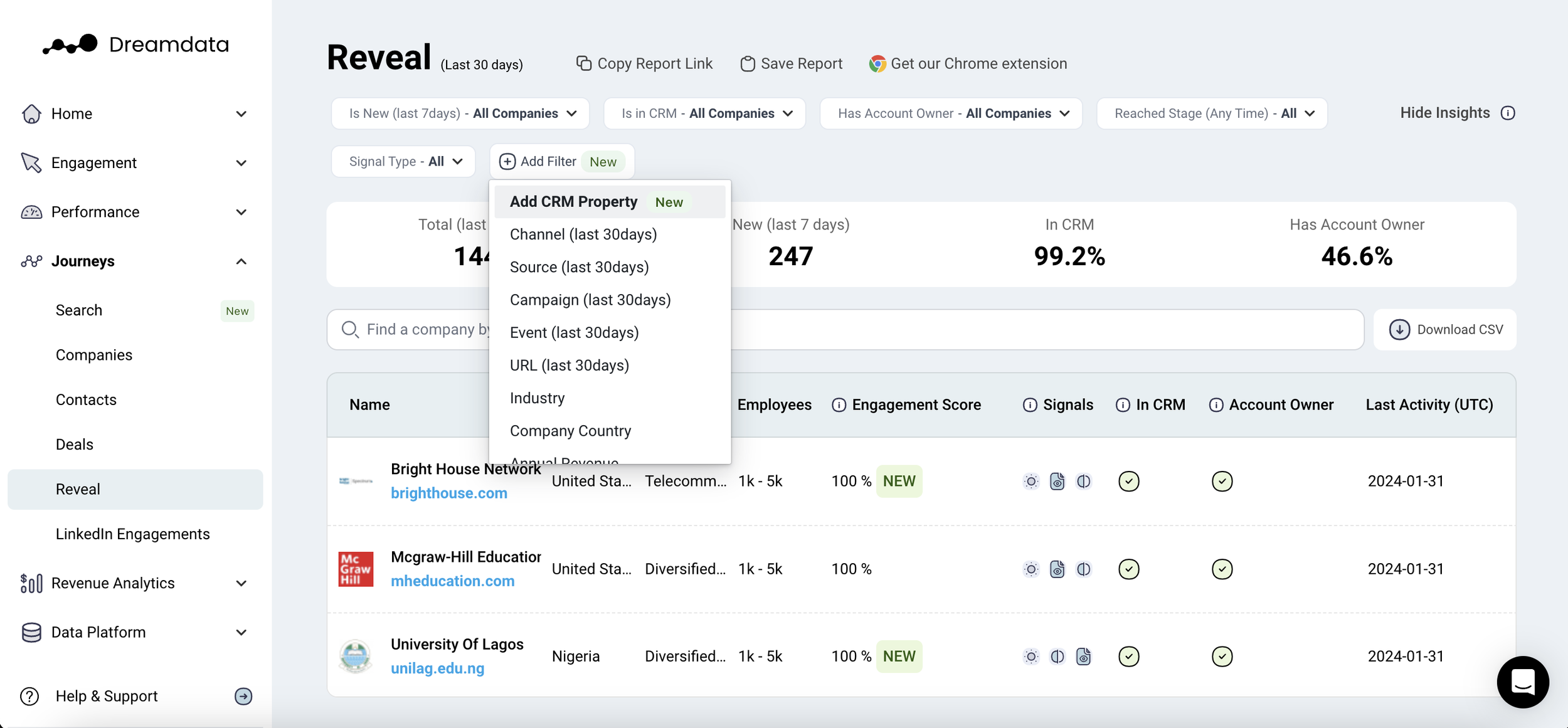
Audience Building & Activation
Dreamdata lets you build audiences using filters across all your data and sync them to ad platforms. For example, you can create a segment of accounts that visited your pricing page twice and retarget them on LinkedIn.
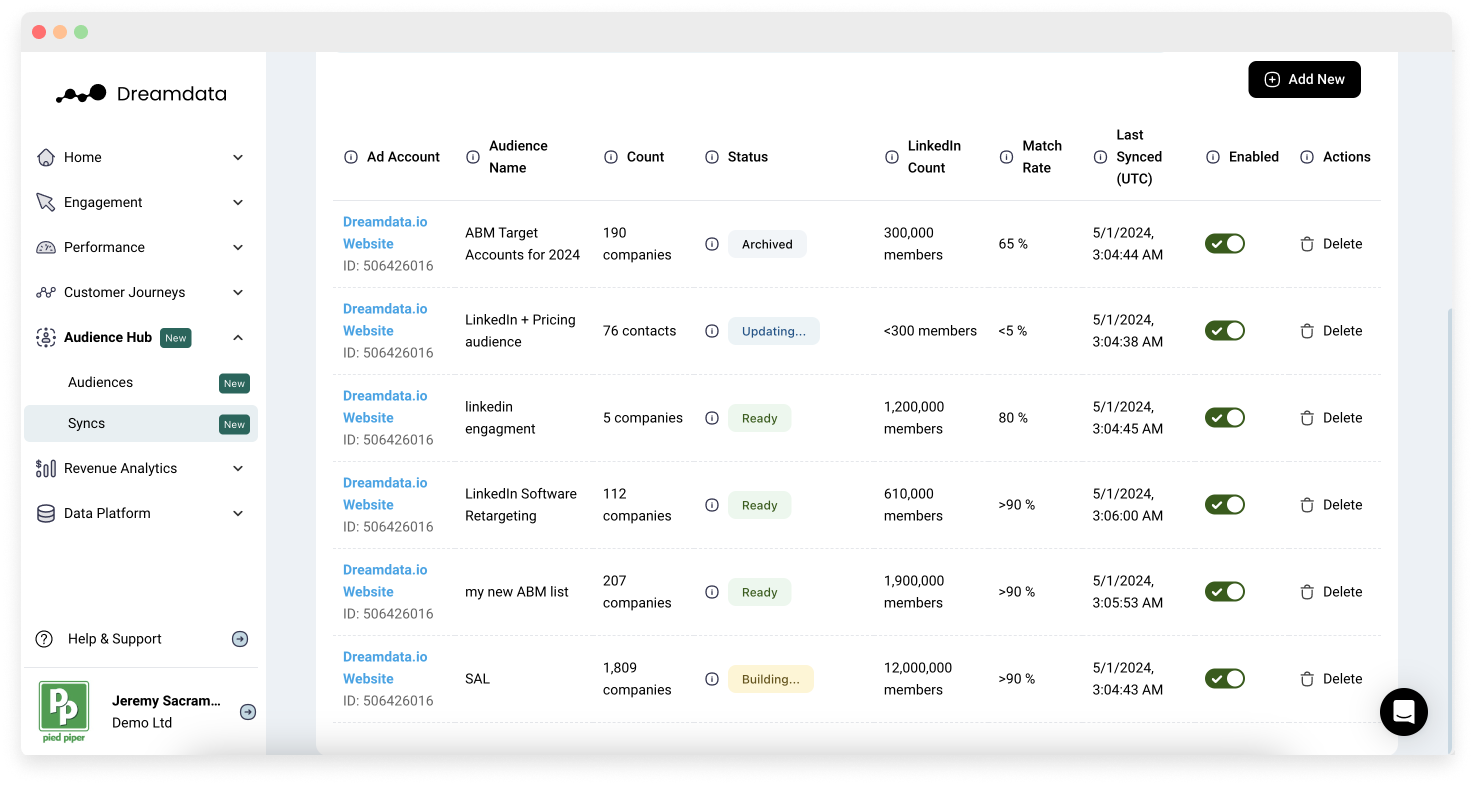
It also supports one-click conversion syncing, so events like SQLs or closed deals flow back into ad platforms for revenue-based optimization.
Integrations

Dreamdata has 40+ integrations across CRMs, marketing automation, ads, analytics, and more.
Big ones:
- Salesforce
- HubSpot
- Microsoft Dynamics
- Marketo/Eloqua
- Google Ads
- LinkedIn Ads
- Facebook/Meta Ads
- Bing Ads
- Twitter Ads
- G2 intent data
- Capterra
- Segment
- Data warehouses
- Outreach
- Salesloft
- Slack
Dreamdata Pricing: How Much Does It Cost?
Dreamdata is not very transparent about pricing on its homepage.
Here is what is publicly available:
- Free Plan: Includes basic account-level tracking, revenue analytics, attribution, audience building, and intent signals. It is more of a starter tier than a long-term option for serious teams.
- Paid Plans: According to G2 and TrustRadius, the “Activation Starter” plan starts at $750 per month. An “Attribution Advanced” tier uses enterprise pricing. Reviews confirm Dreamdata is positioned as a premium solution.
- Vendr puts median Dreamdata pricing at $27K per month.
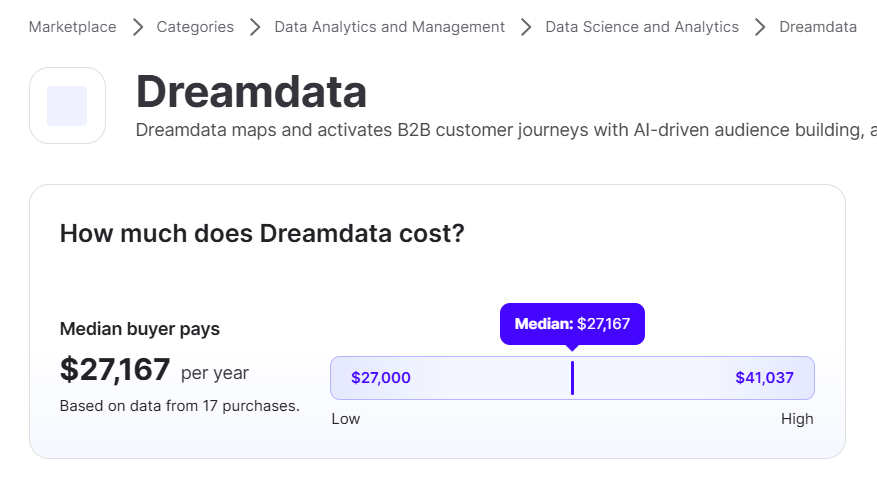
If you are looking for a leaner tool, ZenABM starts at $59/month. It offers account level LinkedIn ad engagement tracking, plug and play dashboards, account scoring, ABM stage tracking, CRM sync, first party qualitative intent, automated BDR assignment, custom webhooks, and job title level engagement tracking.


User Impressions and Reviews
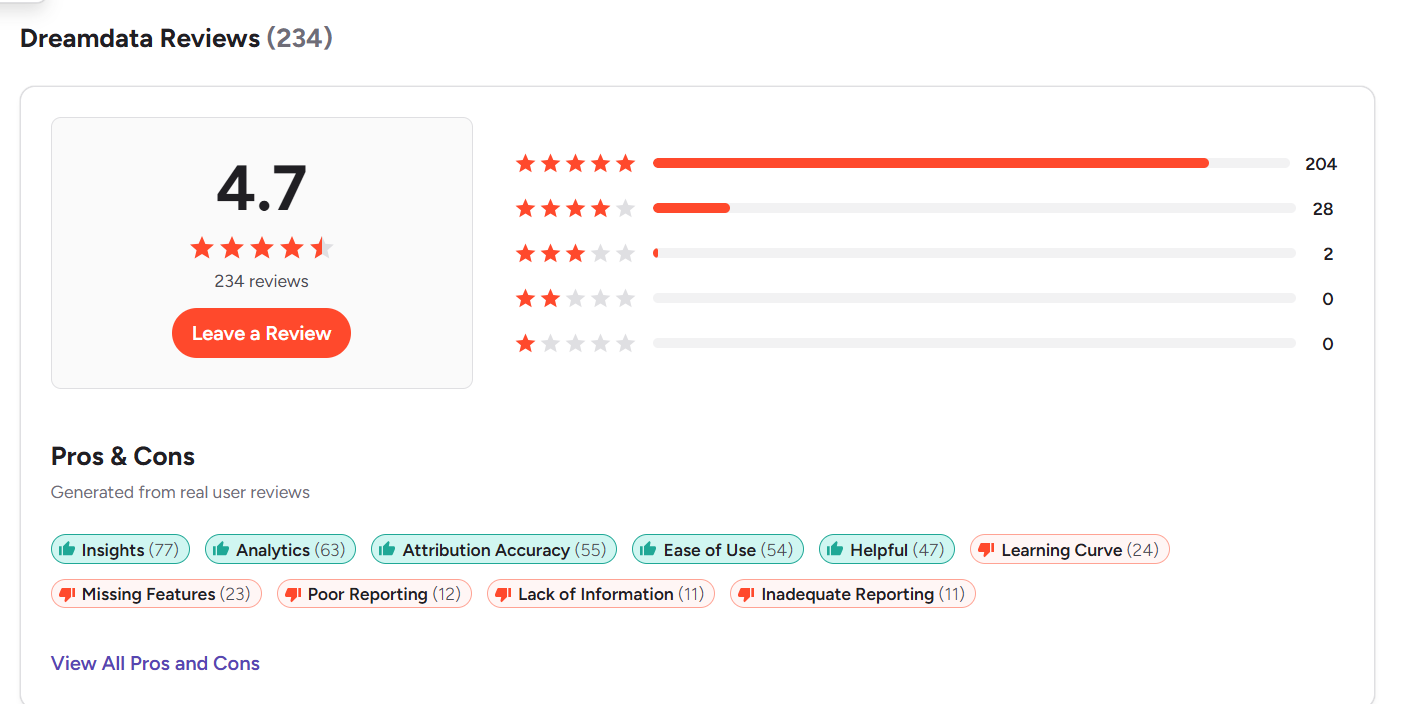
Dreamdata reviews cluster around three themes:
- “We can finally see what works”: Marketers like the clarity Dreamdata brings to B2B funnels and customer journeys, especially for proving that content and top of funnel work influenced revenue.
- “Powerful, but takes time”: Users mention a learning curve, limited customization in some reports, and the feeling that they do not use the whole tool on day one. Data setup and hygiene are key.
- Price and ROI pressure: Several reviewers note that Dreamdata is priced higher than some competitors, so teams expect strong outcomes to justify the spend.
N.Rich vs. Dreamdata: Key Differences
Once you know both platforms, the N.Rich vs. Dreamdata contrast becomes clearer.
| Category | N.Rich | Dreamdata | Where ZenABM Fits |
|---|---|---|---|
| Core positioning | ABM and intent execution platform with its own DSP and CRM driven ICP builder for mid-market and enterprise teams. | B2B activation and attribution platform that maps journeys and ties every touchpoint to the pipeline and revenue. | LinkedIn first ABM platform focused on company-level ad engagement, intent, and routing for LinkedIn campaigns. |
| Main focus | Turn consent-based intent and CRM data into targeted programmatic plus LinkedIn campaigns with account-level attribution. | Unify CRM, web, and ad data into multi-touch customer journeys and revenue analytics for channels and campaigns. | Show which companies see and engage with LinkedIn ads, how they move through ABM stages, and what revenue they influence. |
| Target entity | Accounts and buying groups, scored by ICP fit and topic-based intent. | Accounts and journeys are constructed from many contact and channel touchpoints. | Accounts as the primary unit, with optional job title level engagement views. |
| Activation layer | Native DSP for programmatic display plus coordination with LinkedIn Ads. | Audience building and conversion syncing into external ad platforms rather than running its own media. | Runs on top of LinkedIn Ads only, with ABM campaigns, retargeting logic, and engagement scoring. |
| Intent and data model | A blend of first-party engagement and third-party intent topics tracked in a consent-based way. | Multi-source data from CRM, website, ads, and tools to build journeys and reveal high-intent accounts. | First-party intent derived from LinkedIn ad engagement per company and per theme or offer. |
| Analytics and reporting | Account analytics, opportunity attribution, and ICP sales velocity scores synced back to CRM. | Multi-touch attribution models, revenue dashboards, funnel and time to revenue reporting, and ABM views. | ABM dashboards for LinkedIn spend, account engagement, stage movement, pipeline, and ROAS. |
| Integrations | Salesforce, HubSpot, LinkedIn Marketing Solutions and Sales Navigator, with enrichment on higher tiers. | 40+ integrations including major CRMs, MAPs, ad platforms, data warehouses, and sales tools. | Bi-directional sync with HubSpot and Salesforce on higher tiers, plus webhooks into the rest of the stack. |
| Pricing profile | Tiered annual plans starting above $10K per year, plus onboarding and scaling with topics, users, and campaigns. | Free plan for basics, then paid tiers starting in the hundreds per month and rising into premium enterprise pricing. | Flat SaaS tiers from $59 per month to under $6K per year for agencies, no credit system or media markups. |
| Typical pros from users | Strong intent and targeting, clear account analytics, and responsive support once configured. | Deep visibility into journeys, better ROAS clarity, strong attribution, and helpful onboarding support. | Fast setup for LinkedIn ABM, clear revenue impact, and simple scoring and staging inside the CRM. |
| Typical cons from users | Setup effort, integration surprises, need for clean CRM data, and some feature gaps around usability. | Not trivial to learn, limited customization in some reports, data prep required, and premium pricing. | Deliberately LinkedIn only, so it does not replace a full cross-channel attribution or DSP stack. |
| Ideal team profile | ABM teams that want to run intent-driven programmatic and LinkedIn campaigns with clear account attribution. | Growth and RevOps teams that need to justify spend across many channels and prove what actually drives revenue. | Teams whose primary ABM channel is LinkedIn and who want accurate company-level signals and routing inside the CRM. |
| Best use case | Turning intent and ICP insights into targeted media and measuring impact on pipeline and opportunities. | Answering “which channels and campaigns create revenue” across the entire go-to-market engine. | Maximizing LinkedIn ad-driven pipeline with first-party intent, scoring, stages, and simple attribution. |
N.Rich vs. Dreamdata: So, Which Is Better for ABM?
N.Rich is usually the better fit if your ABM motion is campaign-led and account-heavy. You have a clear ICP, want programmatic and LinkedIn working from the same account list, and care about connecting impressions and visits to opportunities at the account level. If you have the budget and ops support, N.Rich fits that pattern.
Dreamdata fits teams that obsess over attribution and revenue analytics across the whole go-to-market engine. If you are debating which channels and campaigns drive pipeline, need multi-touch models, and want one place to join CRM, ads, and web data into account journeys, Dreamdata is more relevant than a pure DSP-centric ABM layer.
If your main growth lever is LinkedIn and your real question is “which companies are engaging with my ads, how hot are they, and what is my pipeline per dollar”, both tools can feel heavier than you need.
ZenABM as a LinkedIn First, First Party Lean ABM Alternative
If you mostly need first-party accuracy on LinkedIn, account scoring, ABM stages, CRM sync, and revenue attribution, a lighter option makes more sense.
This is where ZenABM comes in. It can complement or partially replace N.Rich or Dreamdata in a LinkedIn first stack.
Account Level LinkedIn Engagement Tracking


ZenABM connects directly to the official LinkedIn Ads API and records account-level data for every campaign. You see which companies view and engage with your ads using first-party LinkedIn data instead of noisy IP or cookie matching. A Syft study suggests IP identification accuracy peaks around 42 percent, which is why ZenABM treats ad engagement as the primary intent signal.
Real Time Engagement Scoring & ABM Stages

ZenABM updates engagement scores continuously as accounts interact with your ads. The interface shows a full touchpoint history and lets you define custom stages such as Identified, Aware, Engaged, Interested, and Opportunity.


CRM Integration and Workflows
ZenABM syncs bi-directionally with HubSpot and adds Salesforce support on higher plans. All LinkedIn metrics can be written as company properties in your CRM.
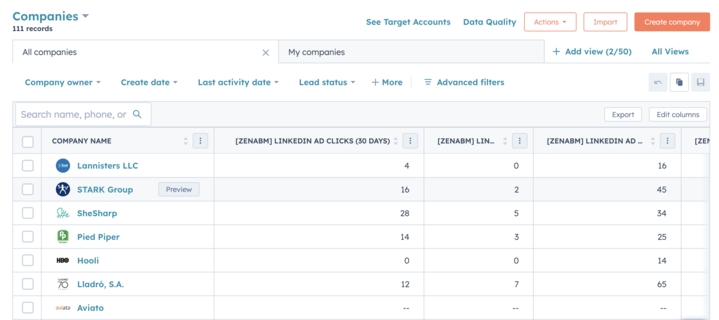
When an account crosses your score threshold, ZenABM updates the stage and can assign a BDR automatically.

Intent Tagging and ABM Analytics
ZenABM lets you pull intent topics from LinkedIn campaigns and tag each campaign by feature, use case, or offer.
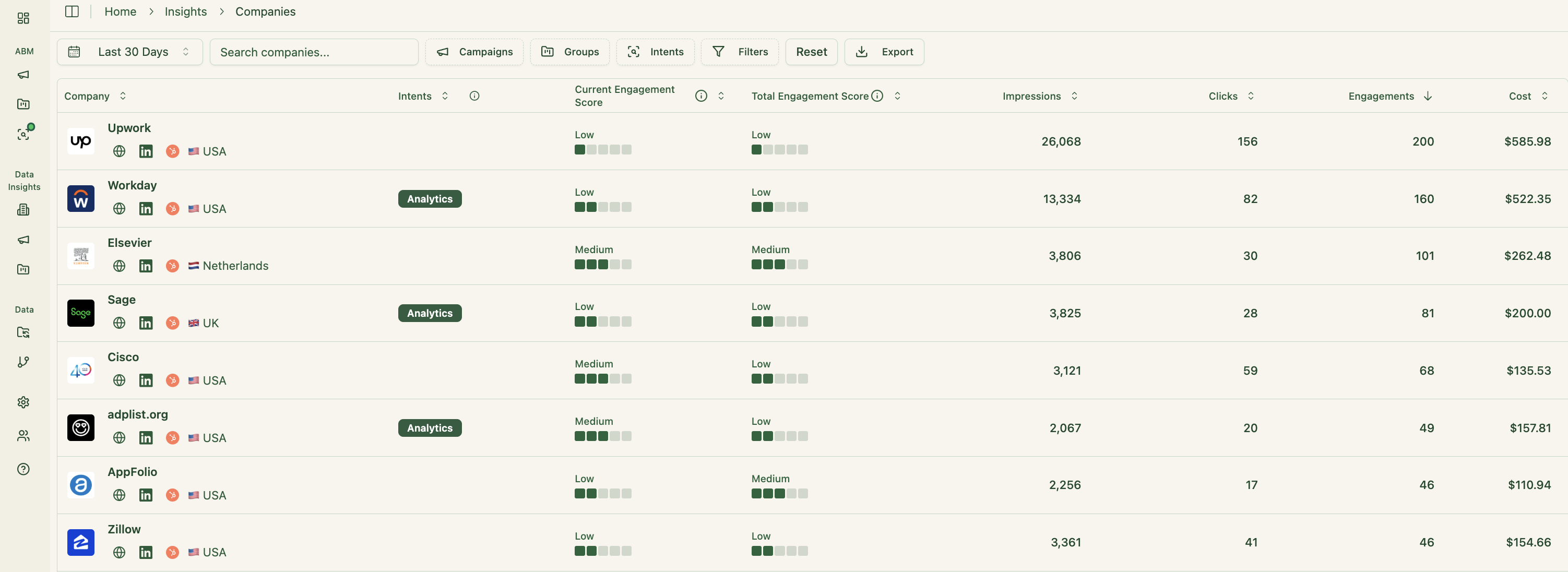
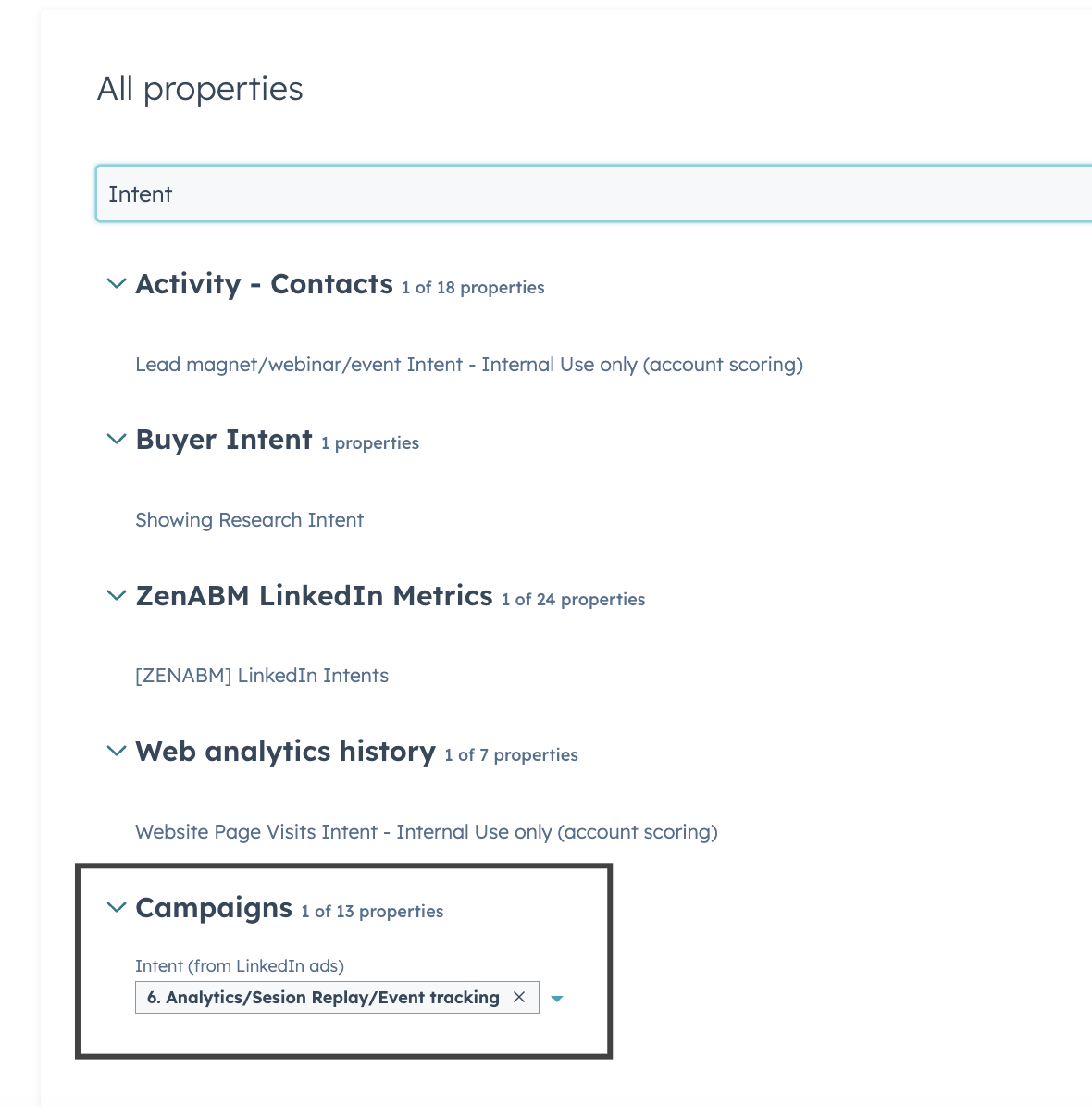
ZenABM includes ABM dashboards that tie LinkedIn ads to account engagement, stages, and revenue. You can see performance from ABM initiatives down to campaign groups and individual ads, and because ZenABM stores deal value and ad spend per company and campaign, it calculates ROAS and pipeline per dollar.
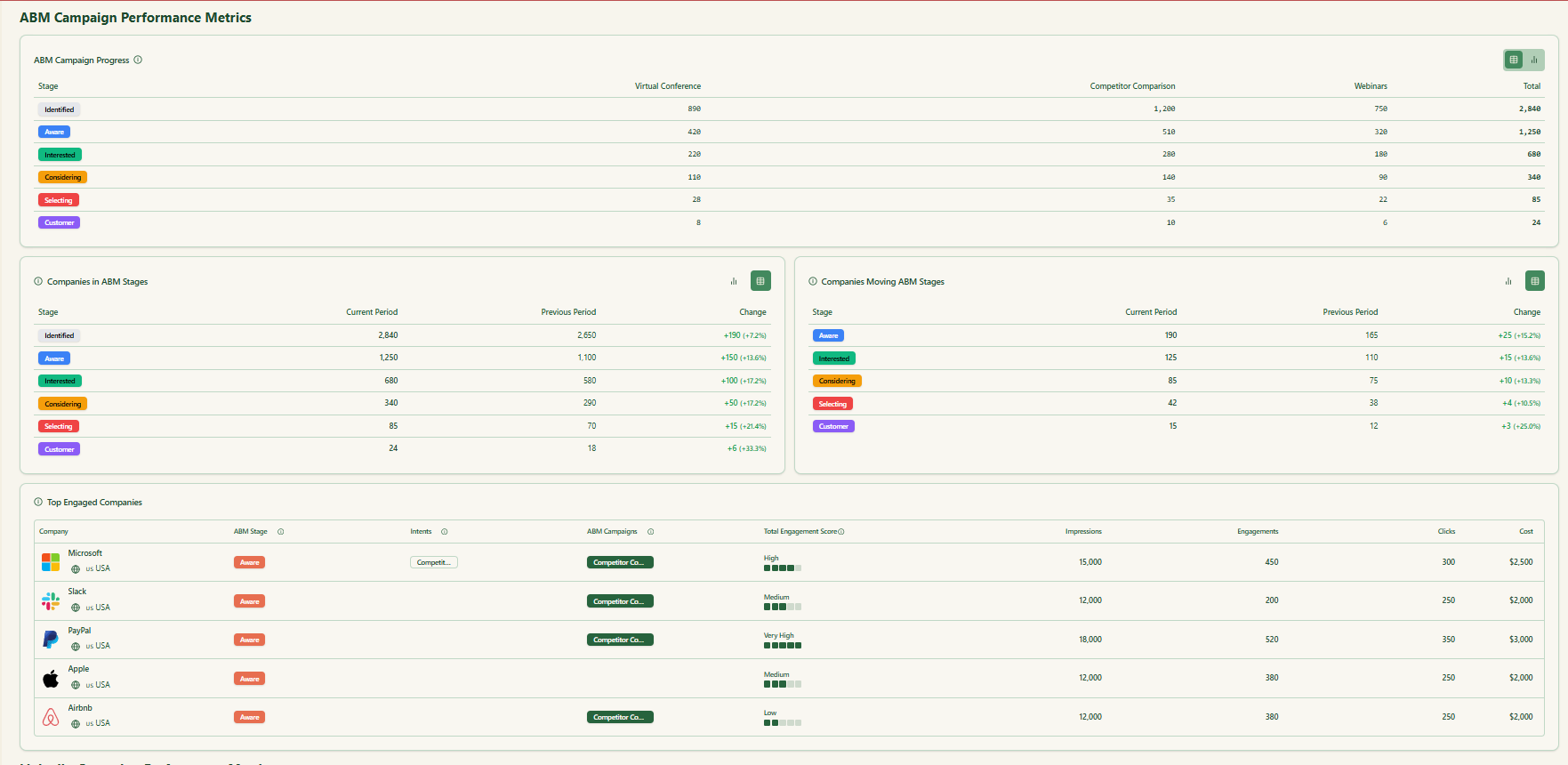

Webhooks, Job Title Analytics & Campaign Objects
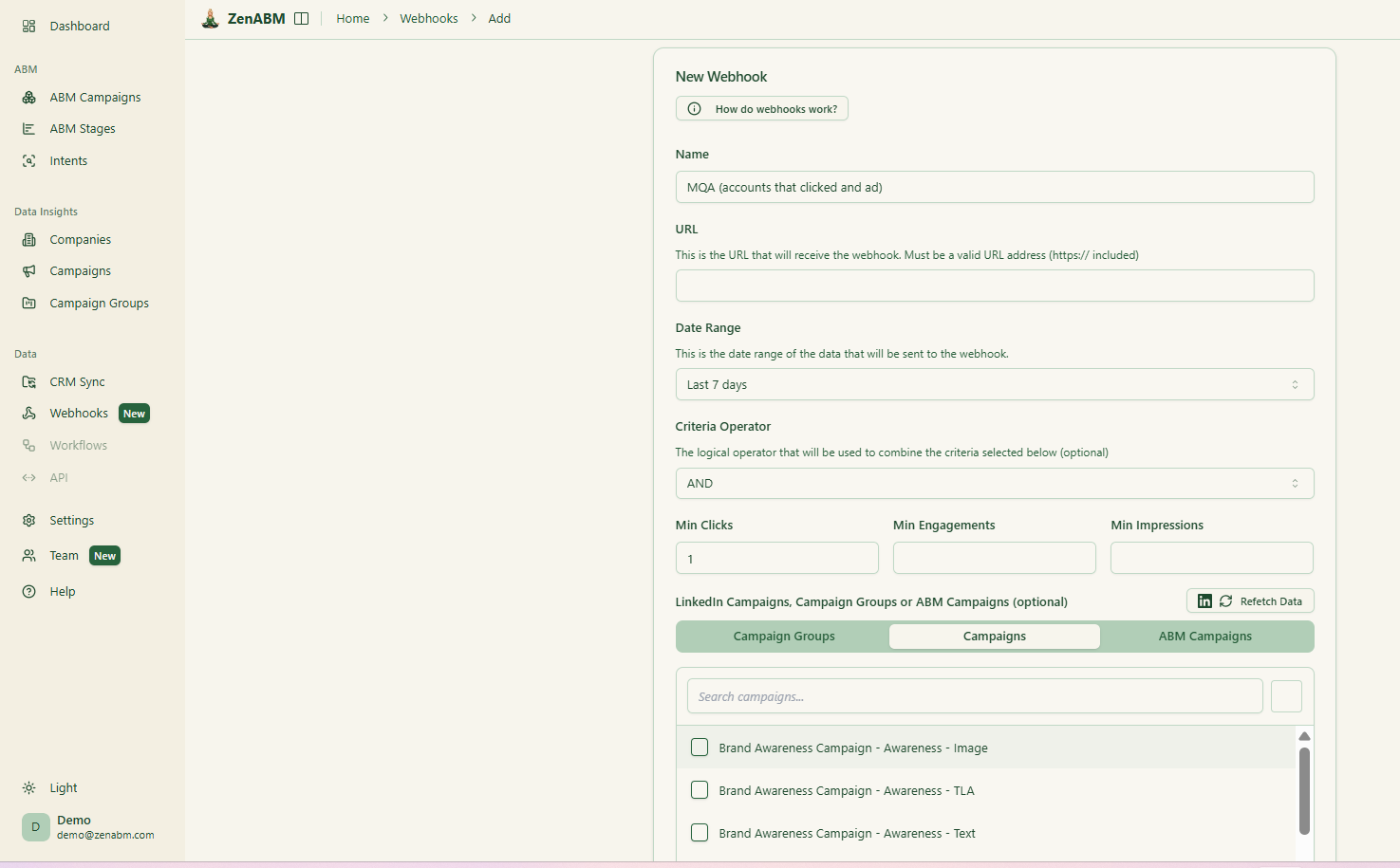
ZenABM webhooks send events into your stack for Slack alerts, enrichment flows, and other automation.
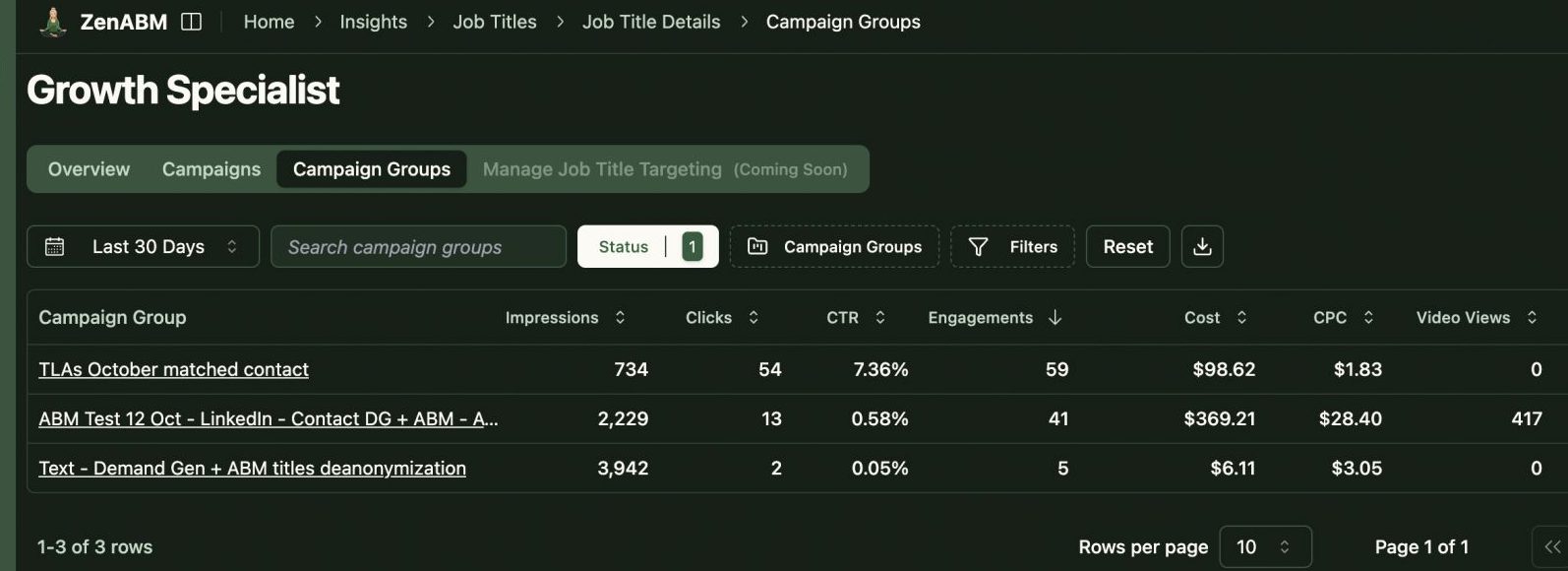
You can also group LinkedIn campaigns into ABM campaign objects to view performance across markets, personas, or creative clusters instead of juggling isolated reports.
AI Chatbot & Multi Client Workspace
ZenABM includes an AI chatbot on top of your LinkedIn API data and ABM model so you can ask questions like “Which accounts moved from Interested to Selecting last month?” or “What is my pipeline per dollar on retargeting campaigns?”.
It also supports agencies via a multi-client workspace, so you can manage several ad accounts and clients with separate ABM campaigns, dashboards, and reporting without constant account switching in Campaign Manager.
ZenABM Pricing
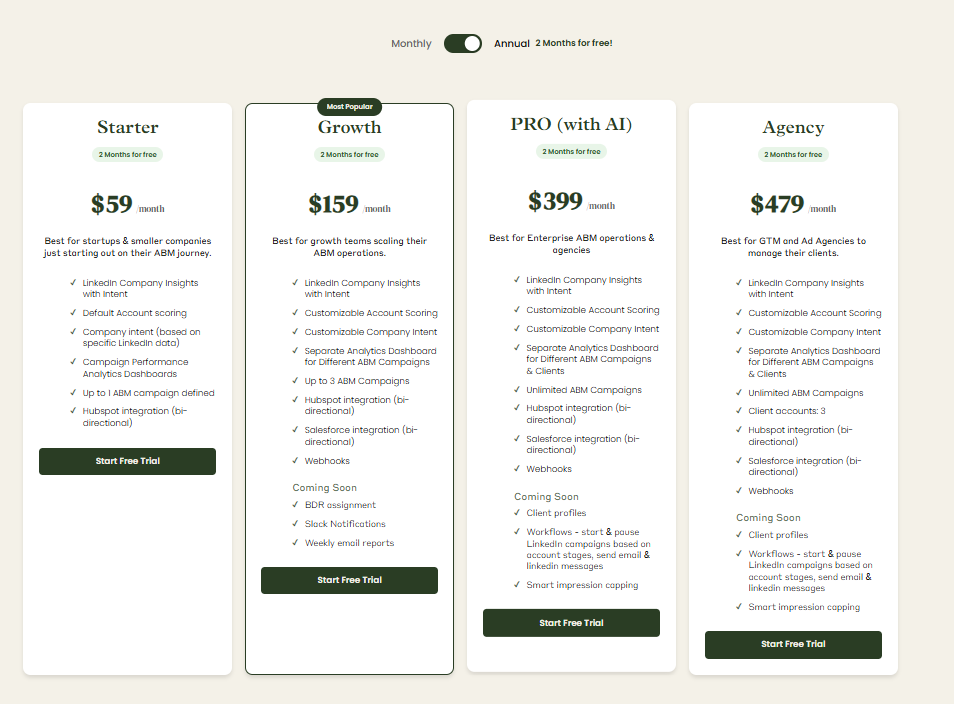
Plans start at $59/month for Starter, $159/month for Growth, $399/month for Pro (AI), and $479/month for Agency. Even the agency plan stays under $6,000 per year, with all tiers including core LinkedIn ABM capabilities. Higher tiers mainly raise limits and add Salesforce sync. All plans include a 37-day trial period.
Conclusion
N.Rich and Dreamdata solve different problems inside an ABM stack. N.Rich is closer to an execution engine that turns ICP and intent data into programmatic and LinkedIn campaigns with account-level attribution. Dreamdata sits closer to analytics and RevOps, rebuilding multi-touch journeys across channels so you can see which investments really drive revenue.
If LinkedIn is your main growth channel and your priority is knowing which companies are engaging with your ads, how hot they are, and what pipeline they influence, both platforms can feel heavier and more expensive than necessary.
In that case, adding or choosing ZenABM gives you a simpler path. You get company-level LinkedIn engagement, first-party intent, ABM stages, CRM sync, and ROAS reporting at a price mid-market teams and agencies can actually live with, without committing to a full attribution suite or programmatic stack.

